
Friedrich Wilhelm Daniel Levi (1888 – 1966) spent over fifteen years teaching in India and had considerable influence on the mathematics curriculum in Indian universities of the time. He fled Nazi Germany in 1935 and came to Calcutta (now Kolkata) where he remained until his retirement in 1948. After a brief stint at the Tata Institute of Fundamental Research in Bombay (now Mumbai), Levi left India in the early fifties and returned to Germany. In the words of Raghavan Narasimhan, “Levi played an important part in the acceptance of algebra in university curricula all over India”.1
In this tribute remembering the impact of F.W. Levi on the mathematics curriculum in India, Bhāvanā is republishing, with kind permissions, an English translation of an article originally in German by Otto Kegel and Volker Remmert, and Levi’s 1943 Presidential Address to the Indian Mathematical Society.
Accepting an offer as Hardinge Chair of Higher Mathematics at the University of Calcutta, Levi moved with his family in January 1936 to Calcutta, where he was appointed the head of the Mathematics Department. Taking charge of the job he was entrusted with in earnest, he taught courses and published provisional editions of his book on algebra, the first part Systems of linear equations in 1936, and the second part General Algebra in 1937.
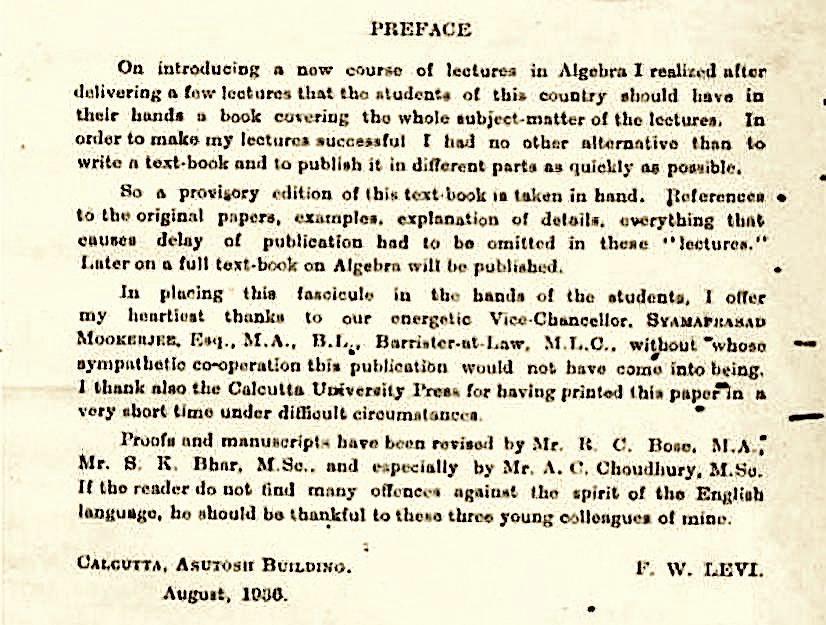
R.C. Bose, who attended Levi’s lectures and seminars, became especially interested in “finite fields” and “finite geometries” and Levi was highly impressed by Bose’s enthusiasm. Bose, whose name later became well-known as one of the “Euler Spoilers” for disproving a long-standing Latin squares conjecture of the Swiss mathematician Leonard Euler, made fundamental use of the theory of finite fields and finite geometries in his construction of designs.
 |
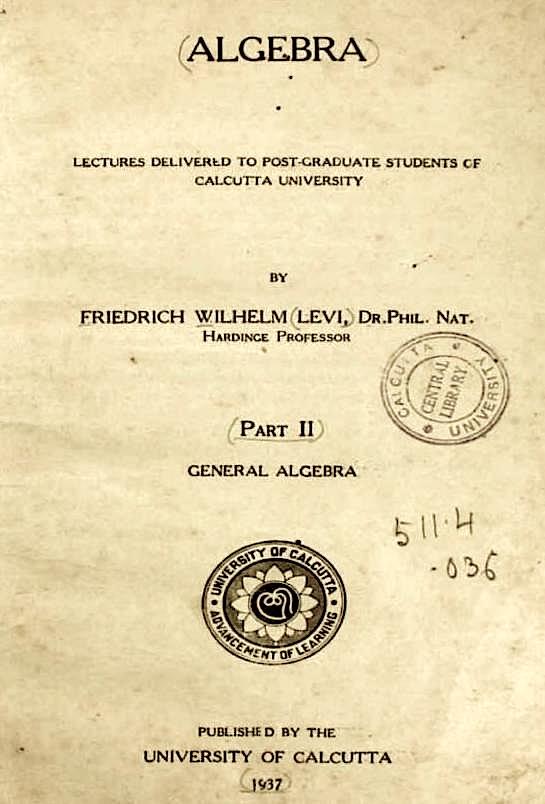 |
| Cover pages of the provisional editions of Algebra by F.W. Levi. courtesy: Internet Archive | |
Levi published over seventy papers on a variety of topics including geometry, but his main contribution is in algebra. His PhD thesis, written under the supervision of Heinrich Weber and submitted to the University of Strassburg in 1911, deals with integral domains and fields which are cubic extensions of the field of rationals. His Habilitationsschrift2 on the theory of abelian groups, submitted to the University of Leipzig in 1914, is considered to be his major contribution. But the publication of this work only later in 1917 when he was serving on the front in World War I, and not in any journal, meant that it did not become widely known at that time. In a detailed account of Levi’s work by L. Fuchs and R. Göbel,3 the authors write:
It is most regrettable that this pivotal work was printed as a separate piece of publication, and not published in a major journal. Its influence would have been considerably greater and the development of Abelian group theory would have been probably faster if it were accessible to those interested in Abelian group theory. As a matter of fact, he discovered several theorems which we erroneously attribute to others, due to our ignorance of the content of this paper.
Certain of Levi’s work in algebra draws on ideas from geometry and topology. His joint paper with Richard Baer,4 written around the time of his moving to India, uses an idea of Arthur Cayley which transfers the abstract group theoretic setting to fundamental groups of topological complexes.5
The two provisional editions of his books on algebra mentioned earlier, along with sections on continued fractions, approximation of roots, and matrices, were eventually turned into a full-fledged 305-page textbook titled Algebra, vol. 1, published by the University of Calcutta in 1942. Elaborating on the contents of this more comprehensive edition, Fuchs and Göbel write:
[It] is an introduction to abstract algebra for graduate students. It discusses the basic algebraic structures and some number theory (like continued fractions). A few topics which are usually not included in graduate algebra texts are also studied, e.g., approximation of roots, Sturm’s and Budan–Fourier’s theorems etc. Important features are the numerous examples which make the book especially useful for students. Levi completed the manuscript of the second volume in which abelian groups, finite groups, Galois theory, commutative and non-commutative rings were discussed at length, but this volume has never been printed in book form.
While in India, Levi took an active part in the meetings of the Calcutta Mathematical Society (CMS) and the Indian Mathematical Society (IMS). A letter from 1945 that he wrote to Homi Bhabha, reproduced here, speaks of his inclination to house the library of the IMS at the newly started TIFR. In the same letter, he goes on to say, “I believe that an all India research centre (in statu nascendi) needs contact with all the sources of scientific life in the country – and you will find something of it in this society”. The text of his presidential address at the annual conference of the IMS in 1943, which is republished in this issue, is a document worthy of historical analysis. It would perhaps be in order to highlight two aspects of his lecture here, a general one and a specific one.
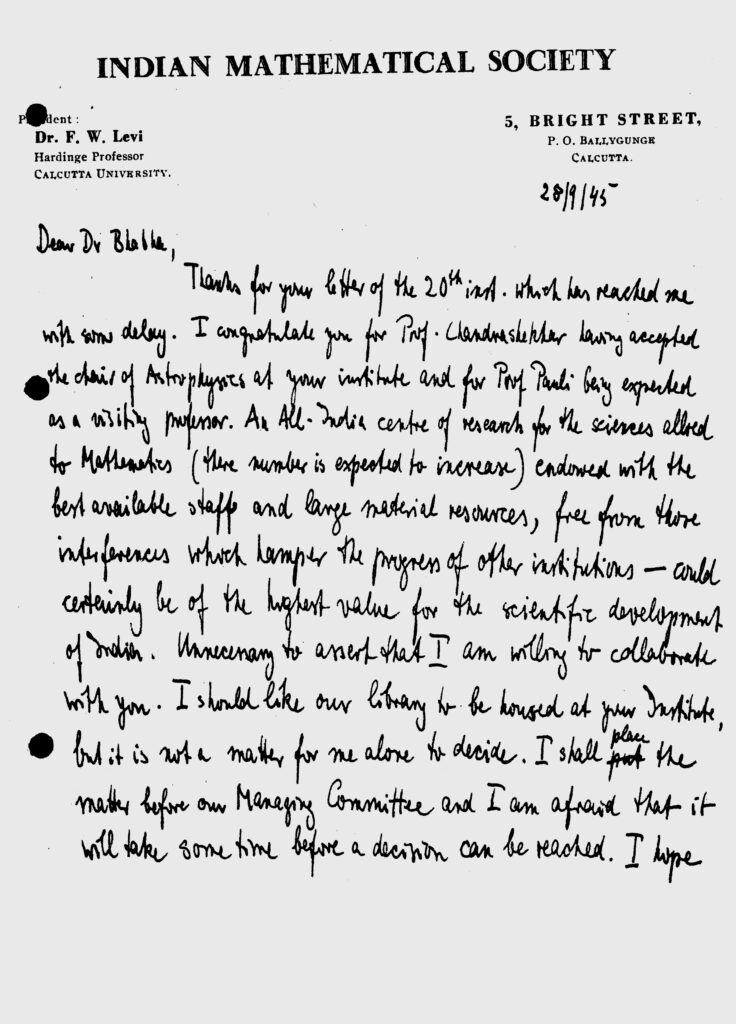 |
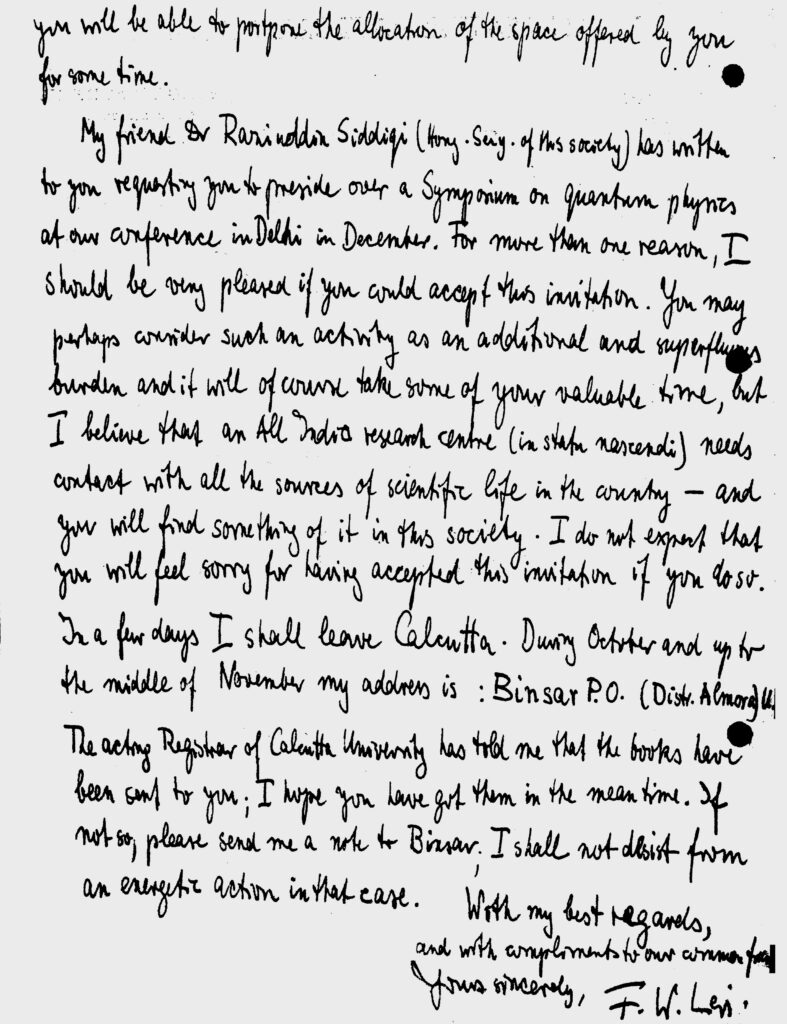 |
| Levi’s 1945 letter as the President of IMS to Homi Bhabha TIFR Archives | |
The general aspect is that Levi’s address is at least partly rooted in the German tradition of mathematicians’ speeches for academic audiences. When taking over the rectorate of a university, a largely representational office in the nineteenth and early twentieth centuries, professors would usually choose topics suitable for a broad academic audience in their inauguration addresses. The same was the case for speeches in academies of science (e.g., Berlin, Heidelberg, Munich). Mathematicians often chose topics such as On the Nature of Mathematics (Über das Wesen der Mathematik, Aurel Voss, 1908), or more specific ones such as On the History of Calculus (Über die Geschichte der Infinitesimalrechnung, Jakob Lüroth 1889) in order to discuss the status of mathematics, its relevance for cultural, economic and social development, the relationship between pure and applied mathematics etc.6 Evidently, Levi would have known this tradition well enough that his aforementioned presidential address seems in keeping with that spirit. This is corroborated by the fact that his 1942 and 1943 presidential addresses to the CMS are titled Topology7 and Modern Algebra8 respectively.
Then the specific aspect is that, in his 1943 address to IMS, Levi mentions his own fate as an émigré mathematician, cut off from his academic roots, if only in passing:
I like to remember the harmony and the spirit of good fellowship prevailing at the meetings of this Society at Lucknow, Hyderabad and Aligarh and the kindness shown by distinguished mathematicians of this country to me as newcomer; moreover I feel much indebted to many mathematicians of other countries – living or deceased – to my teachers and to those with whom I used to exchange ideas.

After reaching the retirement age of 60 in Calcutta in 1948, Levi secured temporary contracts at the Tata Institute for Fundamental Research in Bombay. While he was well respected in India, he was keen on returning to Europe, because he was increasingly unhappy with his situation in India (his health suffered from the climate, his pension was modest, and the political situation was volatile).Thus he travelled to Europe in 1950 and gave a series of talks in England, the Netherlands, and Germany, where he also visited the Mathematical Research Institute in Oberwolfach. As a result of his lecturing trip he secured visiting professorships in Freiburg (1951) and Berlin (1952). At the newly founded Freie Universität in Berlin the mathematician Alexander Dinghas (1908–1974) was determined to hire Levi on a permanent basis and succeeded in doing so in 1952 in spite of the initial opposition of the administration – a standard problem in all similar cases – who considered Levi as being “too expensive”, given that he was already 64 and that his retirement would be due in 1956.
After World War II, Levi was one of only three Jewish émigré mathematicians who permanently returned to a position in a university in Germany, the other two were Reinhold Baer who accepted a professorship in Frankfurt in 1956 and Hans Hamburger (1889–1956) who returned to Cologne in 1953, where he had taught up to 1935.
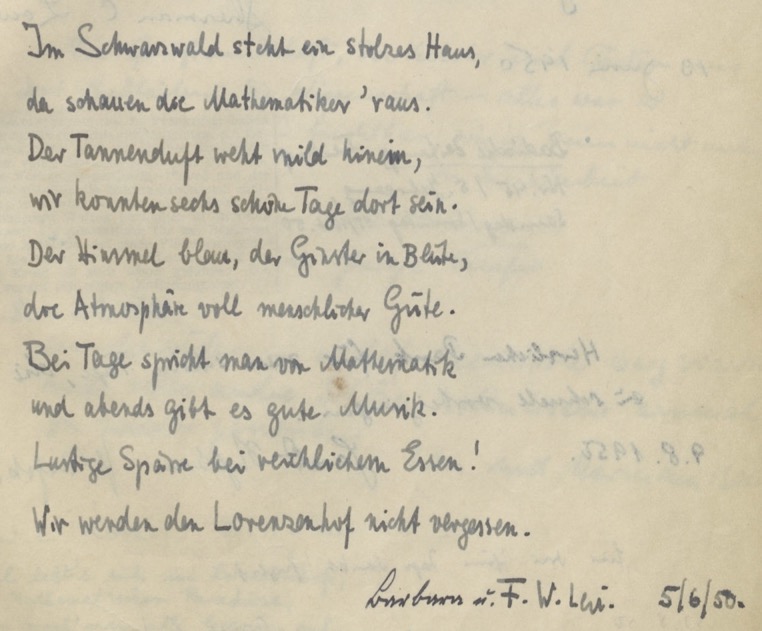 |

|
| Poem in German by Levi on the Mathematical Research Institute at Oberwolfach in their guest book. Mathematisches Forschungsinstitut Oberwolfach To the right is the free English translation of the poem.10 |
|
In post-war Germany, the Nazi past and especially the Holocaust were topics that were rarely addressed.11 This silence stood between Germans and Jewish emigrants, many of whom could not envisage returning to Germany or even reestablishing connections in the face of the ignorant or indifferent stance of most German colleagues. The first steps often were very precarious. An example of this is the correspondence between Levi and Hubert Cremer in Germany. In March 1947, when Cremer learned that Levi’s mother and sister had “been murdered by villainous hands that have forever defiled the name of Germany” he did not shy away, but openly addressed his own regret, “And I feel guilty”. Also, he thanked Levi “that after such atrocities you have not transferred your ever so justified feelings of hatred to me but have even written such a friendly letter”.

The family of Levi appears to have had a quiet life upon their return first to Berlin where he was a professor of mathematics at the Free University from 1952 to 1956. Two years later he moved to Freiburg where he taught at the University of Freiburg until 1961. R.C. Bose and his wife, who had become good friends with the Levis while they were in India, visited them at their home in Freiburg where they had settled down.
Levi left imprints in India not only for his mathematical contributions, but also as a very kind and charming person.
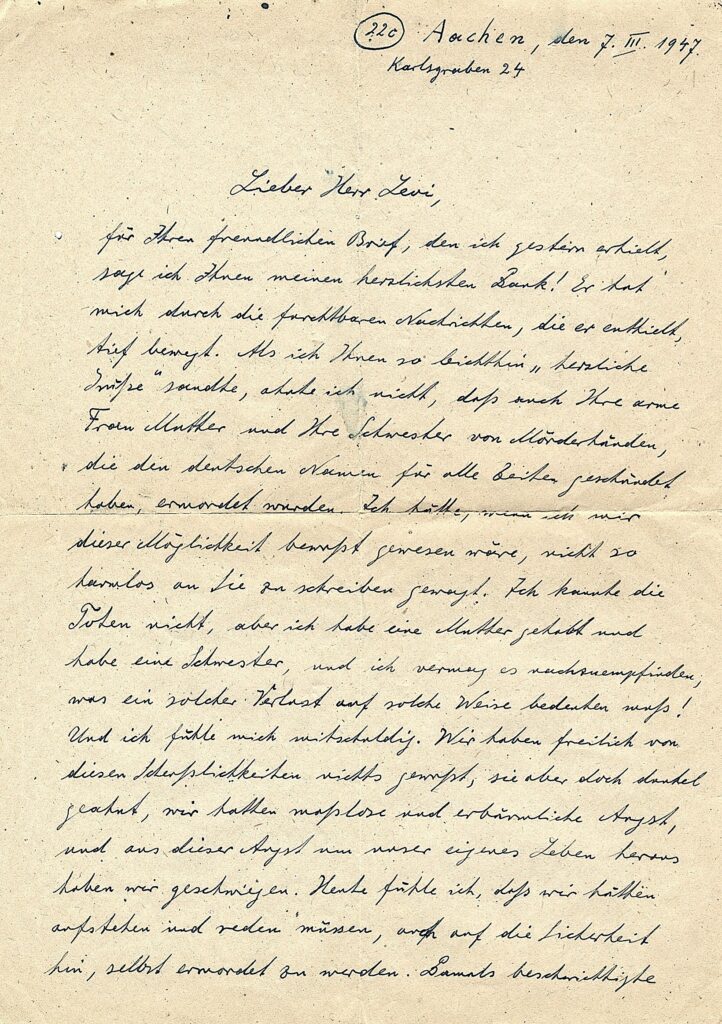 |
 |
| Letter of Hubert Cremer to Levi from 1947. courtesy: Volker Remmert | |
Friedrich Wilhelm Daniel Levi (1888 – 1966)12
by Otto H. Kegel and Volker R. Remmert

[Friedrich Wilhelm] Levi was born on February 6, 1888 in Mulhouse, Alsace, where his father Georg (1856–1942) was a public prosecutor, i.e. a German civil servant. The Levi family soon went to Strasbourg. Levi initially attended a private school there from 1894 to 1896, and from 1896 to 1904 he studied at the humanistic Gymnasium. Levi’s father was transferred to Colmar in 1904 and later became President of the Senate of the Higher Regional Court there. Like so many German Jews, the racist exclusion from 1933 hit him to the core because he did not see himself primarily as a Jewish citizen, but rather as a German citizen. He died in 1942. Levi’s mother Emma and his sister [Franziska] were murdered in the concentration camp Theresienstadt14 in 1943.
Levi passed his high school diploma (Abitur) at the municipal Lyceum in Colmar in the spring of 1906 and did his one-year military service in Würzburg from October onwards. He was also enrolled at the university there. However, he did not begin the actual study of mathematics and physics in Strasbourg until after his discharge in October 1907. He devoted himself primarily to mathematics and attended the lectures of professors Heinrich Weber (1842–1913), Friedrich Schur (1856–1932) and Richard von Mises (1883–1953). Under Weber, Levi wrote his dissertation, Integritätsbereiche und Körper 3 Grades, and received his doctorate in October 1911 with the highest degree.
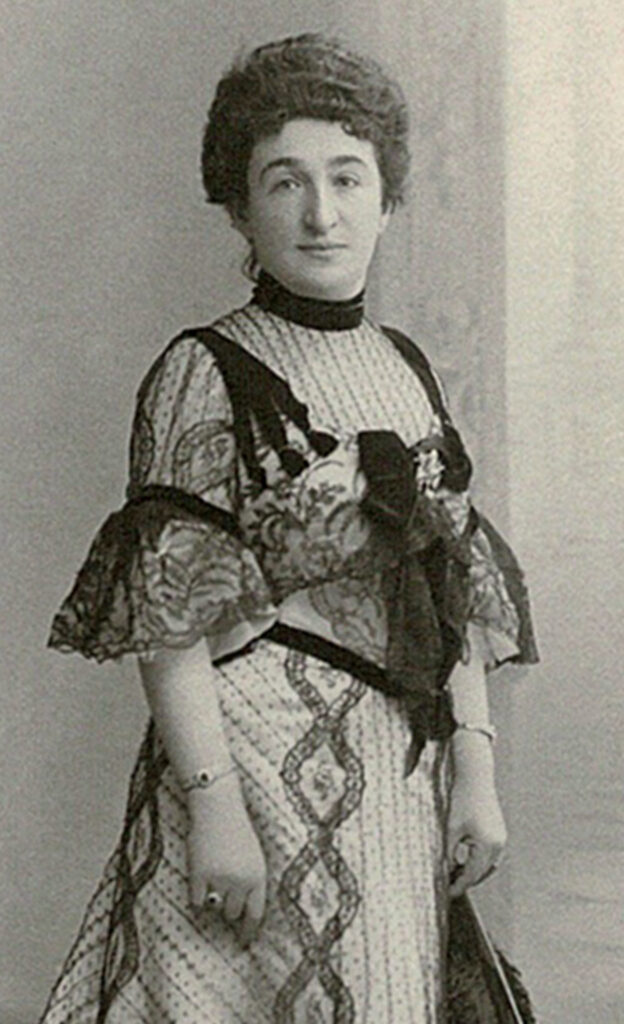

His doctoral supervisor Heinrich Weber died in May 1913. Levi thus lost his main mentor. It is unclear whether he wanted to complete his habilitation with Weber. At least after Weber’s death there seemed to be no chance of habilitation in Strasbourg, especially since Andreas Speiser (1885–1970) had completed his habilitation there in 1911 and perhaps there was no need for another private lecturer. However, Friedrich Schur supported Levi in his efforts to find a place for his habilitation. After Levi received a negative response from Eduard Study in June when he asked whether there was an opportunity for him to complete his habilitation in Bonn, in August, Schur turned to his Leipzig friend Karl Rohn (1855–1920) to help Levi.
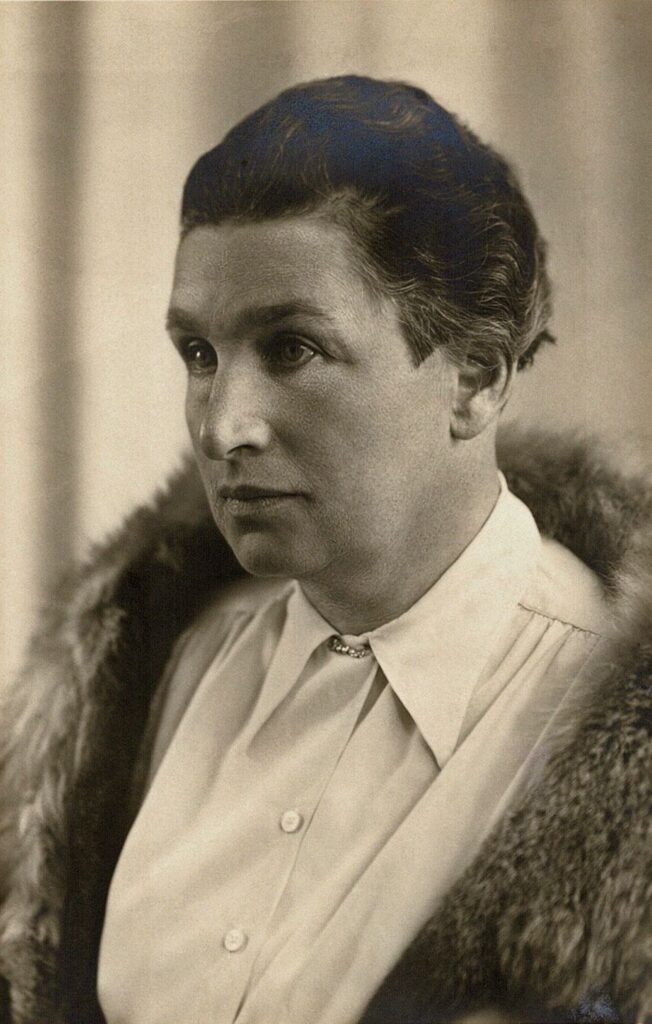
Levi seems to have taken Schur’s advice to heart, because at the beginning of July 1914 he submitted his habilitation thesis Abelian groups with countable elements [1] in Leipzig. The habilitation process started, but the First World War thwarted Levi’s plans. He had already been in military service as a Saxon field artilleryman for three months, when in December Otto Hölder supported admission to the remaining habilitation courses based on his habilitation thesis. However, Levi could not complete the requirements, of a colloquium and an appraisal lecture, during the war because he did not receive any leave of absence for this purpose. However, in December 1916, at the request of the three Leipzig mathematicians Otto Hölder, Karl Rohn and Gustav Herglotz, he was granted permission by the Saxon Ministry of Culture “in consideration of the extraordinary wartime conditions” to have his habilitation thesis printed before the process was completed to maintain the priority of his results.
Levi was in the field as a lieutenant until November 1918, so that the habilitation process was only completed in March 1919, after almost five years, with a provisional lecture on Die Bedeutung der Dimensionszahl bei der axiomatischen Begründung der Geometrie (The importance of the dimension number in axiomatic foundation of geometry). His Spanish friend Julio Rey Pastor (1888–1962) wrote him16 a clairvoyant card soon after the outbreak of the war anticipating the dilemma of suspended scientific and personal contacts and an interrupted career:
When I wrote to you, I could not have guessed that the catastrophe was so close. […] I sincerely wish you the best of luck in the war. I doubt whether you will get this card. If this is the case, I would be very happy if I received messages from you.
During the war, Levi married Barbara Fitting (1894–1992), the daughter of an active officer, whose cousin Hans Fitting (1906–1938) also turned to mathematics and was even a scholarship holder in Leipzig for a while. The couple had three children: Paul, Charlotte and Susanne.
Levi’s academic career was slow after his habilitation: on the one hand, he had only published three papers after his doctorate and was therefore still quite unknown. On the other hand, there were very few jobs available anyway. From 1920, he held an assistant position at the Mathematical Institute in Leipzig, and from 1923 onwards he held the title of Associate Professor (which did not come with a regular salary). He received a permanent, but badly paid teaching position for geometry in the summer of 1926.
During his time in Leipzig, Levi did not get much opportunity to take charge of things. From 1922 onwards, he got on very well with Rohn’s successor, the versatile mathematician and co-founder of the Journal Mathematischen Zeitschrift, Leon Lichtenstein (1878–1933). In contrast, the relationship with the function theorist Paul Koebe (1882–1945), who succeeded Gustav Herglotz in 1926, does not seem to have been uncomplicated. When the Chilean ambassador in Berlin wanted to recruit a mathematician for Chile in 1928, Lichtenstein immediately suggested Levi but without success.
Levi hardly developed any mathematical friendships in Leipzig in the 1920s. It was only when Reinhold Baer (1902–1979) moved from Freiburg to Halle in 1928 that a collaboration and friendship developed between the two, which lasted through Baer’s emigration in 1933. Baer’s wife Marianne’s father Kirstein was the owner of the Seemann-Publishing house in Leipzig. Levi and his wife had established friendly contact with the Kirstein family immediately after the First World War. The acquaintance with Baer went back to the early 1920s. Levi also found a friendly relationship that went beyond purely mathematical contact, with Bartel Leendert van der Waerden (1903–1996) who came to Leipzig in 1931 as Hölder’s successor.
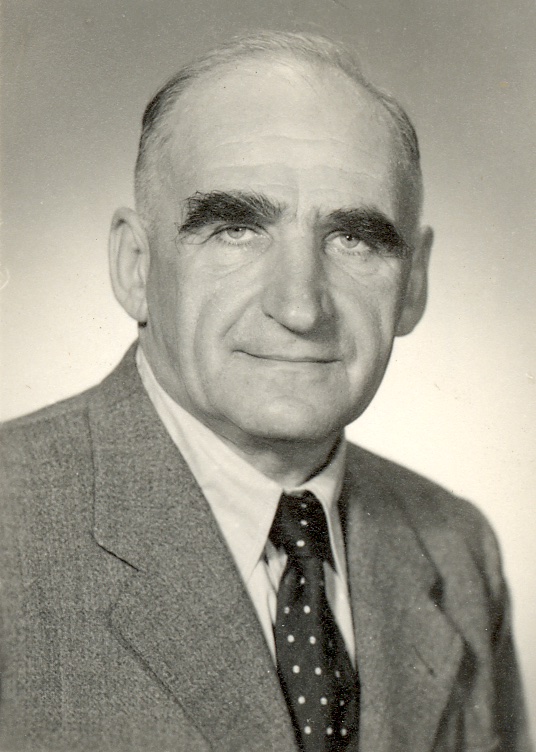
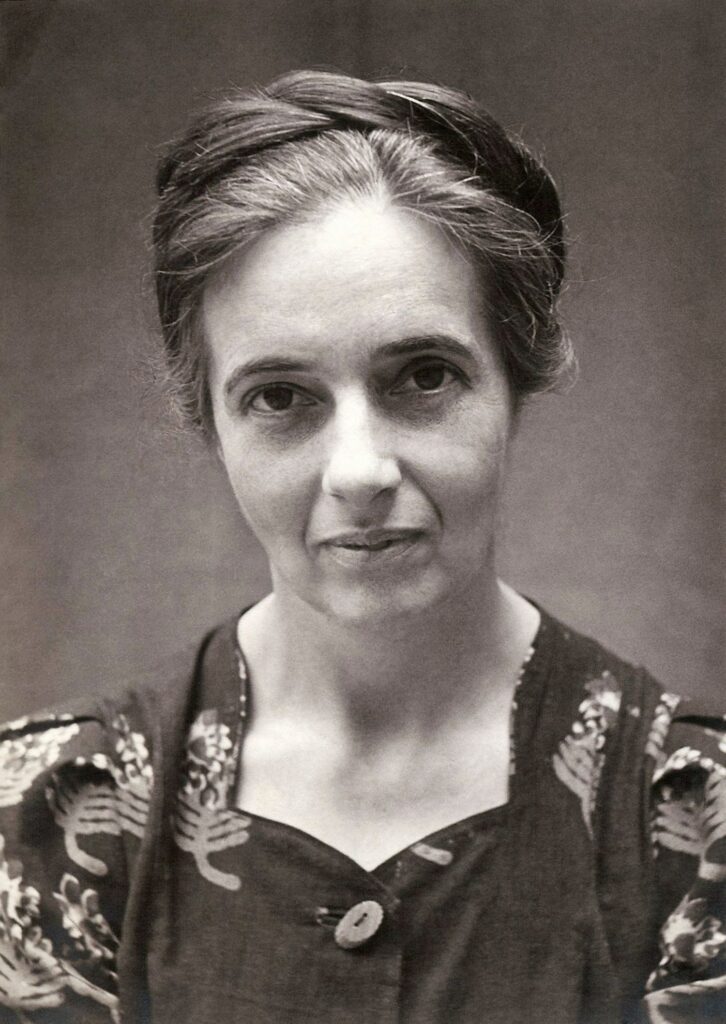
This initiative was part of the usual simulation games carried out by ministries. But in April 1933, the threat to Levi’s livelihood became acute again under the euphemistic title Gesetz zur Wiederherstellung des Berufsbeamtentums (Law for the restoration of the professional Civil Service). This law represented probably the most serious intervention by the National Socialists in the German scientific and university landscape. As a participant in the First World War, Levi was not among those directly affected. The meteorologist Ludwig Weickmann (1882–1961), dean of the Faculty of Philosophy, informed the ministry in mid-April, pointing out that the Leipzig Faculty of Philosophy was “among the least” that “can be expected” to be “Jewified” faculties and so that “a somehow threatening influence of the Jewish element on the spirit of the faculty” would not be feared.17 Nevertheless, Levi was fired in July effective October 31, 1933.
This move was openly criticized in the Leipzig daily newspaper on August 4th. Why, the question was asked in bold letters, was Leon Lichtenstein, “a Polish or Gallician Jew,” allowed to continue to teach at the Mathematical Institute, while Levi, a war veteran with the First Class Cross of Honour, had to leave? In this way, the meaning of the law to restore the professional civil service was reversed. In addition to the attack on Lichtenstein, who, however, died in the same month, van der Waerden was also alluded to by recording astonishment that the German students were willing to suffer, that “foreigners [van der Waerden], one of them even a foreign Jew [Lichtenstein]” taught at the University of Leipzig. A small success for Levi as a result of this humiliating article was that his dismissal was postponed until 31 January 1934.
At the beginning of August, Ludwig Weickmann, who had completed his doctorate under the Munich mathematician Aurel Voss, contacted the ministry again to intervene on Levi’s behalf. He reiterated Levi’s achievements as a frontline fighter, and that his service as a group leader with the Leipzig Temporary Volunteer Regiment in the troubled months of 1919/1920 stood out. According to Weickmann, Levi “also defended the university against the rampant communist gang as a machine gun commander, shoulder to shoulder with the current Prussian Ministerial Councilor Dr. Achelis”. Weickmann argued that Levi, the father of three children, must be allowed “to stay put through a teaching position at least until he found another means of living.” And referring to his involvement in the war and as a temporary volunteer, he questioned as to what “more could a man do to prove his loyalty to the people, that had granted him the status of a guest”?18
The Leipzig physiologist Johann Daniel Achelis (1898–1963) had been ministerial councilor and personnel officer for the universities in the Prussian Ministry of Culture since March 1933 and thus seemed to be at the beginning of a promising career, which, however, only lasted until September 1934 in the ministry. Achelis confirmed Levi’s commitment, and in December 1933 Levi finally received a paid teaching position.
In October he had to make a statement about what “future tasks” he saw ahead of him in the coming years as a researcher and teacher. First and foremost, he mentioned the completion of a comprehensive book on group theory together with
van der Waerden. Other than the work on group theory, he saw his field of activity to be primarily in the foundations of geometry. With regard to mathematical teaching, he was of the view that it should not be limited to imparting knowledge, but should have as its goal “education to become a mathematician”.
 |
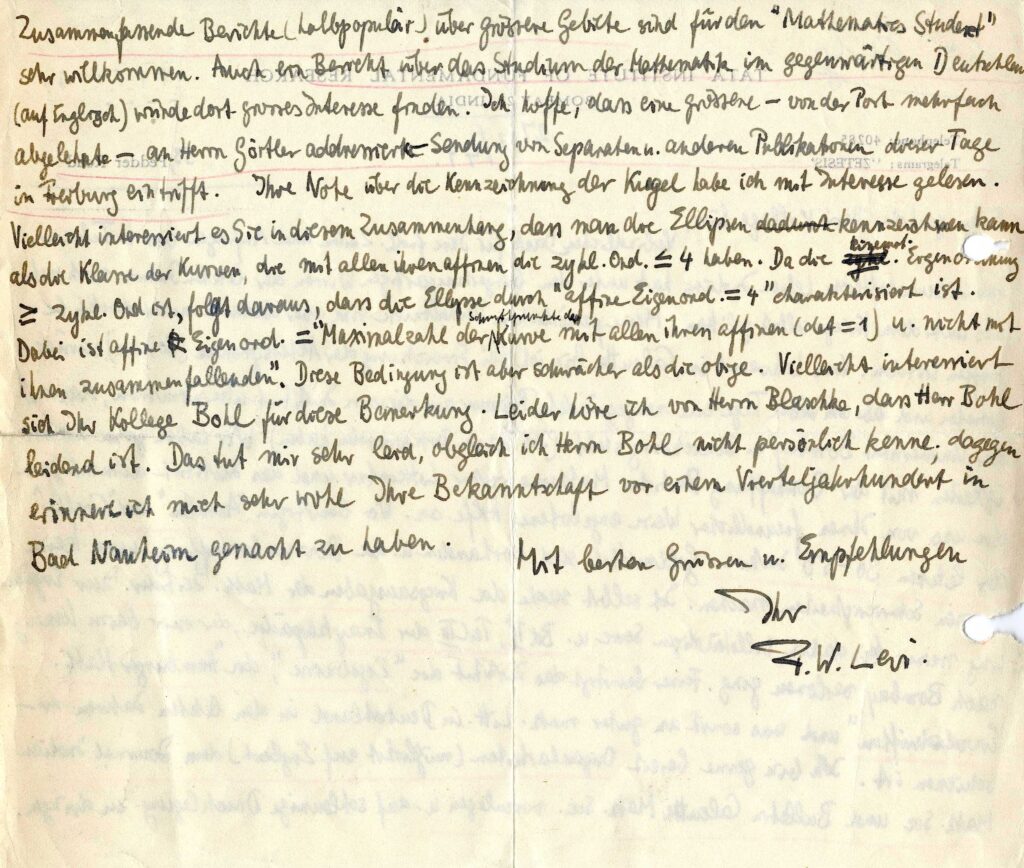 |
| F.W. Levi’s 1949 letter to Wilhelm Süss. courtesy: Volker Remmert | |
The year 1934 may have given the impression of a certain stability in his position, especially since Levi was even granted foreign currency for a trip to England to see Reinhold Baer in the summer. But in April 1935 he was informed that the Reich Governor was withdrawing his licence to teach at the University of Leipzig at the instruction of the Saxon Ministry for Education. Levi immediately appealed against his dismissal to the Reich Ministry of Education and even went there personally – but without success.
Levi’s dismissal was one of the five that the Reich Governor had announced referring to the law to restore the professional civil service (along with Ernst Bettmann, Benno Landsberger, Joachim Wach, and Fritz Weigert). There was heated discussion about this in the Faculty of Philosophy. Werner Heisenberg and Friedrich Hund made no secret of their dismay at the layoffs. Van der Waerden expressed himself even more clearly by pointing out that participants in war were expressly excluded from the law. He requested a unanimous petition from the faculty against the decision of the Reich Governor, which “obviously disregarded” the meaning of the law for the restoration of the professional civil service. This initiative immediately earned him a warning from Vice Rector Golf to “be more careful” in his statements in the future.19 There was no change in the layoffs.
Levi, who was said at the meeting to have already had a job offer in Tehran, was now forced to look for a position outside the German Reich. Van der Waerden had already inquired about opportunities for Levi in Holland, Belgium, France and Switzerland in September 1933. He recommended that Levi study actuarial science because it would provide “more real opportunities to earn a living than at universities”. As this would only take a year or two, Levi’s situation was not totally a cause for despair.20
After long months of uncertainty, Levi received an offer in November 1935 to go to the University of Calcutta. There he took up his post as Hardinge Professor of Higher Mathematics in January 1936, initially limited to five years. His application to Calcutta was supported by the mathematicians Harald Bohr (Copenhagen), G.H. Hardy (Cambridge) and André Weil (Strasbourg). The mathematician Richard Courant, who was initially offered the position, rejected it and suggested Max Dehn as a replacement candidate, but to his regret Dehn did not receive it.
Levi stayed at Calcutta, for better or worse, until he reached the age limit of 60 in 1948 and then retired. He initially preferred a job at the Tata Institute of Fundamental Research in Bombay instead of returning to the devastated Germany with its uncertain future. There he received a two-year contract in 1948, which was extended by three years in 1950.
Despite the high reputation that Levi enjoyed in India, he was drawn back to Germany, especially since the climate was detrimental to his health. In the summer of 1950 he gave several guest lectures in England, Holland and Germany. In the summer of 1951, at the invitation of Wilhelm Süss (1895–1958), he taught as a visiting professor at the university of Freiburg. Many German mathematicians tried to get Levi a job in West Germany. Although there were a few voices against such a reparation professorship for Levi, the mathematician Alexander Dinghas (1908–1974) at the Free University of Berlin was determined to appoint Levi. Levi received a visiting professorship at the FU Berlin in the summer of 1952 and, after long disputes between the university and the cultural bureaucracy, he was finally appointed as a full professor in the winter semester of 1952/53. He had prematurely terminated his contract at the Tata Institute in Bombay which was soon expiring anyway.
After his retirement in March 1956, he held this position for another year. But then he was drawn back closer to his native Alsace, so he went to Freiburg, where he initially replaced the late Wilhelm Süss in 1958 and taught as an honorary professor until 1961. This fifth farewell to teaching duties was also the last. He died on New Year’s Day in 1966.
Looking back, Levi was an algebraist with broad interests. Since his habilitation thesis [1] was not widely distributed, important results contained therein were found again by others and became known under their names. Today, however, Levi is recognized as one of the founders of the theory of infinite Abelian groups.
In mathematical studies of analysis and geometry, topology became a major topic at the beginning of the 20th century – and especially after the First World War. Levi’s early geometric contributions are summarized in his book Geometric Configurations [2]. His geometric and combinatorial considerations are of interest even today. The emerging transition from combinatorial to algebraic topology can be seen here in his presentation of surface topology and even seems to be foreshadowed for higher dimensions.
Levi’s topological and algebraic interests were one of the reasons that led to his collaboration with Reinhold Baer. Levi and Baer published several joint papers that extended from topology to combinatorial group theory, in which they investigated subgroups of free groups and free products [3-5, 7]. Burnside’s problem of whether a finitely generated group with a finite exponent is finite concerns both of them. For exponent 3, Levi was able to answer positively and conclusively in collaboration with Bartel Leendert van der Waerden [6].
In his numerous smaller mathematical notes, Levi studied a variety of questions, some of which, such as rings with polynomial identities, semigroups and group theory, only became relevant later. He also published in the area of Helly’s theorem in convex geometry [13, 14]. In this area, one of his questions has only recently been solved.
In India, Levi had to deal with a completely unfamiliar and partly rigid teaching system. He complained that “real penetration into the material was being replaced by mere memorization”. Levi opposed the systematic communication of a prescribed material, and advocated questioning and an axiomatic method of unfolding ideas. This sentiment was reflected in his regular classes, and especially in his “Presidential Addresses” to the Indian Mathematical Society [10-12]. For the curriculum in India, Levi wrote two textbooks on algebra and analysis [8, 9]. Because of his commitment to designing the curriculum, he was generally viewed as the father of algebra in India.
References
- [1] F.W. Levi, Abelsche Gruppen mit abzählharen Elementen, Leipzig 1917.
- [2] F.W. Levi, Geometrische Konfigurationen, Leipzig 1929.
- [3] R. Baer and F.W. Levi, Ränder topologischer Räume, in: Berichte der Sächsischen Akademie der Wissenschaften 82 (1930), 171–189.
- [4] R. Baer and F.W. Levi, Stetige Funktionen in topologischen Räumen, in: Mathematische Zeitschrift 34 (1931), 110–130.
- [5] R. Baer and F.W. Levi, Vollständige irreduzible Systeme von Gruppenaxiomen, in: Sitzungsberichte der Heidelberger Akademie der Wissenschaften 2 (1932), 3–12.
- [6] F.W. Levi and B. L. van der Werden: Über eine besondere Klasse von Gruppen, in: Abhandlungen des Mathematischen Seminars Hamburg 9 (1932), 154–158.
- [7] R. Baer and F.W. Levi, Freie Produkte und ihre Untergruppen, in: Compositio Mathematica 3 (1936), 391–398.
- [8] F.W. Levi, On the Fundamentals of Analysis, Calcutta 1939.
- [9] F.W. Levi, Algebra I. A Textbook for Postgraduate Students, Calcutta 1942.
- [10] F.W. Levi, Topology. Presidential Address 1942, in: Bulletin of the Calcutta Mathematical Society 34 (1942).
- [11] F.W. Levi, Modern Algebra. Presidential Address 1943, in: Bulletin of the Calcutta Mathematical Society 35 (1943), 1–6.
- [12] F.W. Levi, Why Mathematics? Presidential Address 1943, in: The Mathematical Student 11 (1943).
- [13] F.W. Levi, On Helly’s Theorem and the Axioms of Convexity, in: Journal of the Indian Mathematical Society 15 (1951), 65–76.
- [14] F.W. Levi, Eine Ergänzung zum Helly’schen Satz, in: Archiv der Mathematik 4 (1953), 222–224.
- [15] R. Baer, In memoriam Friedrich Wilhelm Levi, in: Freiburger Universitätsblätter 12 (1966), 9f.
- [16] M. Pinl, Kollegen in einer dunklen Zeit III, in: Jahresbericht der Deutschen Mathematiker-Vereinigung 73 (1973), 153–208, hier 188-191 [with a bibliography of Levi’s publications].
- [17] L. Fuchs and R. Göbel, Friedrich Wilhelm Levi, 1888-1966, in this edited volume: Abelian Groups. Proceedings of the 1991 Curaçao Conference, New York 1993, 1–14 [with a bibliography of Levi’s publications].
- [18] H. Begehr, (Ed.): Mathematik in Berlin. Geschichte und Dokumentation, 2 Volumes, Aachen 1998, Volume 1, 180–183 and 332–341.
On Levi
Why Mathematics? by F.W. Levi21

I could not raise this question at today’s festive occasion without believing in the importance and necessity of mathematics, but I ask the audience not to take the question mark as a mere rhetorical figure, some doubts and scruples uttered at the beginning of the speech to let the subject appear even more radiant in an apotheosis at the end of the address. The question is asked in full earnest; the answer, far from being complete, is only an attempt to give some clues to what seems to me the foremost arguments justifying mathematics as a science and the principal reasons for the importance of its further advancement. For this investigation we have to try a descent to the depth where the roots of science are to be sought, but let us start from the surface.
In general a mathematician is as profoundly convinced of the importance of his subject as are e.g., painters, sculptors, musicians and actors. A painter, asked why he paints, may answer that he feels compelled to do so and he may refer the questioner to the books on the philosophy of art stored in the libraries to gratify his theoretical curiosity. This attitude is sincere and respectable though it does not involve a satisfactory reply to the question. A mathematician has an easier way to face—or at least to escape—such a challenge. “Mathematics” he may say “is a complex subject, but its usefulness is evident by its applications. Without mathematics there would be no railways, steamers, motorcars nor aeroplanes. The production of our industrial age is based on mathematical calculations and the administration needs mathematical applications of statistical data. Thus mathematics is an essential prerequisite of modern economic life”—There is nothing untrue in a reply of this kind, but nevertheless it is insincere because it avoids the main issue: the value of mathematics in itself. The boasting reference to the successes of applications of mathematics is a convenient expedient to avoid a superficial conversation with frivolous people about a serious topic, but even from a purely practical point of view there is some danger in it. It is not good to burden mathematics with the responsibility for modern life and all its consequences which show many embarrassing features. People may argue that the destruction of mathematics may bring about the fall of the whole structure of modern life which is based upon it. It is not so long ago that the progress of science and engineering made the public expect the approach of a golden age in the future, perhaps even in the near future. Philosophers and other observers who were horrified by certain cultural developments of that period, were disregarded, but in later years events and changes in political, social and economic life reduced and eventually shattered the hope of a golden age due to scientific and industrial uplift; again people looked back to a golden age of simplicity and safety at a time unknown to the historians, since history records only blood, sweat and toil—and the longing for a golden age. “Beatus ille qui procul negotiis ut prisca gens mortalium” (Blessed who is far from business as were people at some remote time); this ode of Horace is two thousand years old, but it touches even the non-believer in golden ages. How fortunate to live far from the troubles of economic life, far away in a lonely place. Man will find time to think of himself, to dive into his own soul and to salvage the treasures hidden there. He may become a saint or a poet or perhaps a mathematician. Mathematics existed and was appreciated long before there were motors and telegraph lines; it is not a child of the age of engineering though certainly the printing press, libraries and easy communications are greatly helping its advancement; we must be grateful for all these institutions. But the only really essential thing for mathematics is the man and his mental power. In his own soul he finds the material to build up a new world, material as unpretentious and simple as e.g., the numbers and the notion of space.
We enjoy its harmonious beauty and the triumphant moments of successful thinking
The idea of number contains “plurality” as well as “order”; this so to speak inborn interconnection of two important notions in one, makes it particularly fit as a basis of further logical developments. The creative will of the thinking mathematician now intervenes and starts operating on the original objects, e.g., he might combine two pluralities into one by addition. By reversing the operation he gets a new operation, the inverse operation; other operations can be created by combining operations by a rule involving a certain order. Similarly the combination of the same operation with itself, the iteration. involves an index of plurality indicating how often the operation is repeated. As pluralities can be expressed by numbers, the iteration of an operation A can be considered as a new operation which depends on one parameter more than A. This “promotion of an index of operation to a numerical parameter” is a very important method; it leads to new problems at a later stage when the notion of number is generalised. A new and important step is taken when the operations are made new elements, the “operators”; then the combination of the former operations is considered as an operation on those new operators. In this manner the sphere of entities to be considered and of mental activities to be performed by the mathematician increases indefinitely. Every system created in this way creates an opportunity for a new system formed by the automorphisms of the first one, but the seed of this branch of mathematics is the idea of number combining in itself “plurality” and “order”. In this way the original idea of number re-enters mathematics at every stage of investigation. The objects of the operations may be different from numbers; they may even be freely created elements which have no meaning by themselves and there is no limitation for the selection of operations except that they have no self-contradicting properties. However the natural numbers are coming in of necessity as “pluralities” and “indices of order” so that when replaced at one place by generalising notions, they return so to speak at a higher plane. So mathematics shows the basic importance of the concept of numbers in the fabric of our mind; moreover it furnishes also the proper method to investigate the true meaning of “space”.
Although geometry has been treated through millennia, it is still an inexhaustible well of new ideas. Not only masses of special investigations are produced every year, but it seems that the problem of space appears under an essentially new aspect to nearly every generation which is active in mathematics. There is no line of demarcation separating geometry from that branch of our science which is based on the notion of number; they penetrate one another and they have grown together like twin-trees which show only a single stem to the observer though they are springing forth from two separate seeds. Space appears to be an ordered system with a type of order fundamentally different from that of the natural numbers. There is no succession of discrete entities in space and no natural starting point; one is dealing here rather with a homogeneous and isotropic medium without gaps. Notions like point, direction and measure help to disentangle this maze. The latter one furnishes the possibility for applying arithmetic. In doing so, one obtains numbers as “proportions” and this gives another, a geometrical, concept of numbers. Thus plurality, order and proportion are three pre-mathematical ideas from which one can start to obtain the notion of number. Mathematics is based on all three of them; the fact that the further development does not lead to logical difficulties which are more serious than those treated in the theory of the continuum, shows that those basic ideas can be considered to be compatible.
some of the achievements of the scholars of ancient India anticipated results of western scholars living in later centuries
These few remarks show already how mathematics discloses the nature of the fundamental elements of our intellect or, at least, of some of them. Simultaneously it amplifies ways of thinking—namely the mathematical ways—by all those methods which form the mathematical literature. An enormous display of intellectual force and dialectic skill, but not a justification of mathematics, unless mathematics is considered as a value by itself without any reference to anything else. If however one adopts this point of view, the question: “Why mathematics” has no sense. On the other hand, we renounced a claim based on the value to be attributed to engineering and similar applications of mathematics. So we got the net result that mathematics is the outcome of some basic ideas of our mind which we feel compelled to investigate and which by the help of progressing mathematical investigation are proved to be interconnected in various ways. One could speak of the introspective value of mathematics. I do not suppose that any other intellectual method has reaped so many and so important results for introspection, but we should not forget or conceal the fact that these results are the harvest of millennia. However the introspective value of mathematics is not its only justification. We should reconsider the case and for this purpose let us ascend again from the depth of the human soul and the seeds of the notions to the surface of life. Using the deductive method I shall shortly review the reasons why individuals and peoples deal with mathematics.
At all times and in every country, there is the “mathematics of the bazaar” the arithmetic of buying and selling, of counting coins, goods and transports. Through ages it has changed very little; only in modern times it was increased by subjects like actuarial science and economic statistics which sometimes apply advanced mathematical methods. Besides this commercial arithmetic, other types of mathematics have been developed in the centres of culture throughout. history; they owe their origin to a great variety of different reasons. For instance the geometry of ancient Egypt is based on the needs of topographic survey. The mathematics of the Middle East is influenced in the first place by problems of astronomy; this holds for the period of the cuneiform characters as well as for the much later period of the Arabic mathematicians. The scholars of ancient India developed a mathematical science in which the theory of numbers prevails; some of their achievements have anticipated results of western scholars living in later centuries. It seems that besides astronomy and chronology, the requirements of the Vedic ritual are responsible for the ways on which the Hindu mathematicians of those days proceeded. The mathematics of Hellas starts from the philosophy of Pythagoras who claimed to have found the leading principle of the world order in the notion of number. On this foundation, the scholars of ancient Greece built up their mathematics which was the prototype of all theoretical sciences. At the present time mathematics is used all over the world for largely differing reasons. Everybody needs the “mathematics of the bazaar”, a few are devoted to mathematics for its own sake, others apply it for research on astronomy, physics and other branches of science, a great number of people use it for engineering, navigation, survey, actuarial work, statistics and last not least for education. Let us postpone the last item; it will be discussed separately later. This short review furnishes as net result, that mathematics is mostly practised for some kind of application and not for its own sake. Thus we have to take into account the applicability of mathematics as one of its important features even if we refuse to derive its value from the value or non-value of those applications. It is a strange fact that mathematics whose habitat has been found in the human soul has so many applications in the outer world; it is one of those mysteries which we do not recognise as such because we got accustomed to them. Nevertheless we should try to give some kind of explanation.
Some clue could be found in Galileo’s remark that the laws of nature are written in the language of mathematics, but this statement itself is made in the language of a particular philosophy and therefore it must be interpreted first. Laws are human institutions though the underlying principle of justice is of a higher nature. They are imperfect; their value is restricted by geographical and time limits and many offences are committed against them. However the laws given by the Creator to govern nature and supposed to be formulated in the language of mathematics, are in no perceptible connection with the idea of justice; they are eternal and universal; they cannot be broken; they are so perfect that not even room is left for an interference by the Almighty himself. Scientists have established several “laws of nature” and have expressed them in the language of mathematics. So they became able to explain the phenomena of nature and even to predict what will happen on earth and on the firmament whenever certain conditions are satisfied. Some scientists believed that only lack of sufficient mathematics, skill and incomplete knowledge of the physical data concerning the present state of nature prevented them from prestating all the future happenings in nature, since these were supposed to be uniquely determined by the laws of nature. However, experience has confirmed those laws of nature found by the scientists only inside a certain sphere of phenomena; they have to be revised to cover a wider sphere and this procedure of alternating extension of our knowledge of physical facts and revision of the assumed laws of nature persists. Thus the laws found by the scientists are only approximations to the true laws of nature – if there exist such laws. The statements of the physicists are made in the language of mathematics and we may suppose that the same will hold true for the statements to be made in future times, but even from this supposition one cannot conclude that the true laws can be announced in a mathematical form. The scientists of the present time are more modest in their aims than those of the 19th century. Neither do they pretend to know the laws given to nature by the Creator, nor do they expect to obtain this knowledge; they only attempt to lift a little bit the curtain which veils the mystery of nature. I suppose that most of the contemporary scientists when speaking of laws of nature, use this term only as a parable and so they do in many other cases. What seem to be fundamental notions of natural science, were known to the philosophers to be categories of human cognition, but the majority of the physicists were hardly conscious of the implications of this statement before the insufficiency of those notions for a complete description of the happenings in nature became obvious. We lived to see that the categories of time, space, causality can be applied to physics with limitations only and many other notions have been disclosed to be mere parables and images which are very helpful when used inside certain boundaries, but become useless outside of them. Theoretical science has reached a state where all the notions have become questionable and the mathematical method alone has remained permanent.
In the human soul there is nothing so appropriate to help us for an understanding of occurrences in the outer world as mathematics
Thus it appears that in the human soul there is nothing so appropriate to help us for an understanding of the occurrences in the outer world as mathematics; it forms an important link between ourselves and the world around us. It would be a daring attempt to value the treasures of our soul and to put them into an order of merit, but certainly mathematics would not stand in the last place since it helps us to know something of the inner as well as of the outer world. This proves the importance of mathematics in the system of our knowledge and it shows that this science serves other purposes than the private enjoyment of a group of people, called mathematicians, who are obsessed by a cranky desire to investigate topics whose knowledge is of nobody’s concern.
Dealing with mathematics is bound to kindle the flame of love for harmony, truth and spiritual beauty and to give strength to the intellect
If one considers the high importance of mathematics, thus explained, one will understand why Plato did not admit anybody to his Academy who had not a fair knowledge of geometry. From that time dates the close interconnection between mathematics and education. It seems to be necessary to add a few words about this item because whenever the question “Why Mathematics?” is asked in public discussions, it concerns mathematics as a part of education, in particular of general higher education. That elementary mathematics is necessary for the requirements of daily life, is obvious, nor is there any serious objection against the training of experts in that subject by special courses. The debatable topic is whether some knowledge of mathematics above the level of elementary arithmetic is necessary for a well educated man. We should approach this question without any professional bias. Even Felix Klein has admitted that there are very talented persons who are incapable of following the ways of mathematical thinking and that they had better leave mathematics alone. One might however argue that just these people need more than others the strict discipline imposed by mathematical logic. One may expect that the rigorous form of mathematical conclusions will sharpen the critical sense and stiffen the student’s mental self discipline; moreover his experience that he is able to check the correctness of mathematical investigations himself by logical considerations alone is likely to enhance his self confidence and the feeling of responsibility for his own thoughts. Dealing with mathematics is bound to kindle the flame of love for harmony, truth and spiritual beauty and to give strength to the intellect. If these considerations are correct, one must expect the professional mathematicians to be rare specimens of human perfection since they are living all their life under the purifying influence of their science. However, looking at the biographies of eminent mathematicians – e.g., perusing Bell’s “Men of Mathematics” – one will find that even this class of people are not free from short-comings of character. In the glaring light of biographical investigations some unpleasant features become visible which fortunately remain hidden to most of the contemporaries. Thus there is no wonder that my own impression about mathematicians is much more favourable. I like to remember the harmony and the spirit of good fellowship prevailing at the meetings of this Society at Lucknow, Hyderabad and Aligarh and the kindness shown by distinguished mathematicians of this country to me as a newcomer; moreover I feel much indebted to many mathematicians of other countries—living or deceased—to my teachers and to those with whom I used to exchange ideas. My general impression is that mathematicians, compared with other individuals of the same social classes, are amenable people, a rule which—as it has to be—is confirmed by very distinctive exceptions. However I have some doubts whether a few periods a week of mathematical teaching has a favourable influence on the character of the average student. As a matter of fact, educationists are pointing more to the training of intelligence by mathematics than to its influence on the character. So the controversy concerns the question: How far is mathematics helpful or necessary for the training of the intellect and how far should it be replaced by other means of instruction? A new element is coming into these discussions through the claims of several professions for a better and more specific mathematical training of their recruits and the suggestion that the foundations thereof should be laid by the general education. The complaints of the engineers are well known. Moreover I may mention that in public discussions arranged by the Calcutta Mathematical Society, a very distinguished American hygienist, strongly supported by two of his Indian colleagues, urged the necessity of some training in statistics for all the members of the medical profession. It is very probable that the same need will be felt soon for various other practical activities, e.g., general administration. To satisfy such claims, important changes in the system of teaching are necessary, but these are meeting many difficulties. Unfortunately in many countries the curricula for teaching mathematics are still based more on tradition than on practical and educational considerations. Besides this outer difficulty, there is another one originating from the very nature of mathematics. It is impossible to form a curriculum simply by putting together those topics which are of particular practical or educational value. In mathematics everything is interdependent and every theory needs its proper foundation. Therefore a good syllabus must be a compromise considering many endeavours and necessities; in every country every generation of mathematicians and educationists has to fulfil this task without being afraid of its difficulty. In mathematics first things must come first, whereas education wants a progress from the easy to the difficult; these two claims are often conflicting. For this reason the teaching of mathematics has its particular difficulties and it demands the highest standard of knowledge and educational skill from the teacher. Sceptics may ask whether the results justify such efforts: I personally believe that in every country better results could justify even much higher efforts. A detailed treatment of these educational questions as far as India is concerned must be left to the discussions during this meeting. Also at previous meetings, our Society has spent a considerable time on problems of mathematical education. These concern mathematics for education as well as education for mathematics. As mathematics has been proved to be an important branch of human activity, mathematicians have the duty to hand down their knowledge to succeeding generations and to make suitable educational arrangements for this purpose.
Mathematics is an arts-subject and simultaneously the basis of all the science-subjects with which it is connected in an indissoluble manner
With these remarks on education, I may conclude my observations why mathematics is practised and why it must be practised. It has often been discussed whether it is an arts or a science subject; to many people it seems to stand on the border-line. I should not like to put it in this way. While arts-subjects are those concerned with the inner, and science-subjects those concerned with the outer world, mathematics is an arts-subject and simultaneously the basis of all the science-subjects with which it is connected in an indissoluble manner. So it stands as a symbol for the unity of the human mind.\blacksquare
Footnotes
- See “Coming of age of mathematics in India”, Bhāvanā, 1(1), 2017, pp. 37–51. ↩
- Habilitationsschrift is the university degree in which the candidate fulfils a university’s set criteria of excellence in research, teaching, and further education, which usually includes a dissertation. ↩
- L. Fuchs and R. Göbel, Friedrich Wilhelm Levi, 1888 –1966. Abelian groups (Curaçao, 1991), 1–14. Lecture Notes in Pure and Appl. Math., 146 Marcel Dekker, Inc., New York, 1993. ↩
- Freie Produkte und ihre Untergruppen, Compositio Math. 3 (1936), 391–398. ↩
- Possibly still nascent at that time, these ideas, effectively used by Michael Gromov in the mid `80s to study certain infinite groups, are fundamental to what is today known as geometric group theory – a major research field during the past four decades. ↩
- Volker Remmert and Ute Schneider, Eine Disziplin und ihre Verleger – Disziplinenkultur und Publikationswesen der Mathematik in Deutschland, 1871–1949, Bielefeld 2010, chapter 3. ↩
- Topology, Bull. Calcutta Math. Soc. 34 (1942). ↩
- Modern algebra, Bull. Calcutta Math. Soc. 35 (1943), 1–6. ↩
- Volker Remmert, Jewish Émigré Mathematicians and Germany, Bergmann, Birgit/Epple, Moritz (eds.), Transcending Tradition: Jewish Mathematicians in German-Speaking Academic Culture, Heidelberg et al. 2012, 241–270. ↩
- Editor’s note: The translation of the poem from German is ours. ↩
- Volker Remmert, Forms of Remigration: Émigré Jewish Mathematicians and Germany in the Immediate Post-War Period, Mathematical Intelligencer, 37(1) (2015), 30–40. ↩
- Editor’s note: This is an English translation of the original article in German published in the Verlag der Sächsische Akademie der Wissenschaften zu Leipzig. It is published here with kind permission from the original publisher as well as both the authors of the article. Rendering into English is ours, and we are grateful to Volker Remmert for vetting the translation and for his inputs. ↩
- The biographical information adheres to the files in the Leipzig University Archives (UAL), in the Saxon Main State Archives in Dresden and in the Freiburg University Archives, as well as the literature listed in the references at the end. A small part of Levi’s papers is located in the archives of the Geological Association in the Freiburg University Library. ↩
- Editor’s note: Theresienstadt was a Nazi ghetto in the Protectorate of Bohemia and Moravia—the German-occupied Czech lands—built inside a repurposed fortified town, Terezín. ↩
- Schur to Levi, 23 December 1913, Archives of the Freiburg Geological Association. ↩
- Rey Pastor to Levi, August 2, 1914, Archives of the Geological Association of Freiburg. ↩
- Phil. Faculty to Ministry of Public Education, April 19th 1933, UAL, PA 689, p. 41. ↩
- Weickmann to Ministerial Councilor v. Seydewitz, 4 August 1933, UAL, PA 689, p. 43f. ↩
- Minutes of the meeting of May 21, 1935, UAL, PA 689, pp. 65–67. ↩
- Van der Werden to Levi, 13 September 1933, Archives of the Geological Association of Freiburg. ↩
- This article was originally published in The Mathematics Student with the title “Why Mathematics?” pp. i–ix, 1943, and is republished here with permission. ↩
